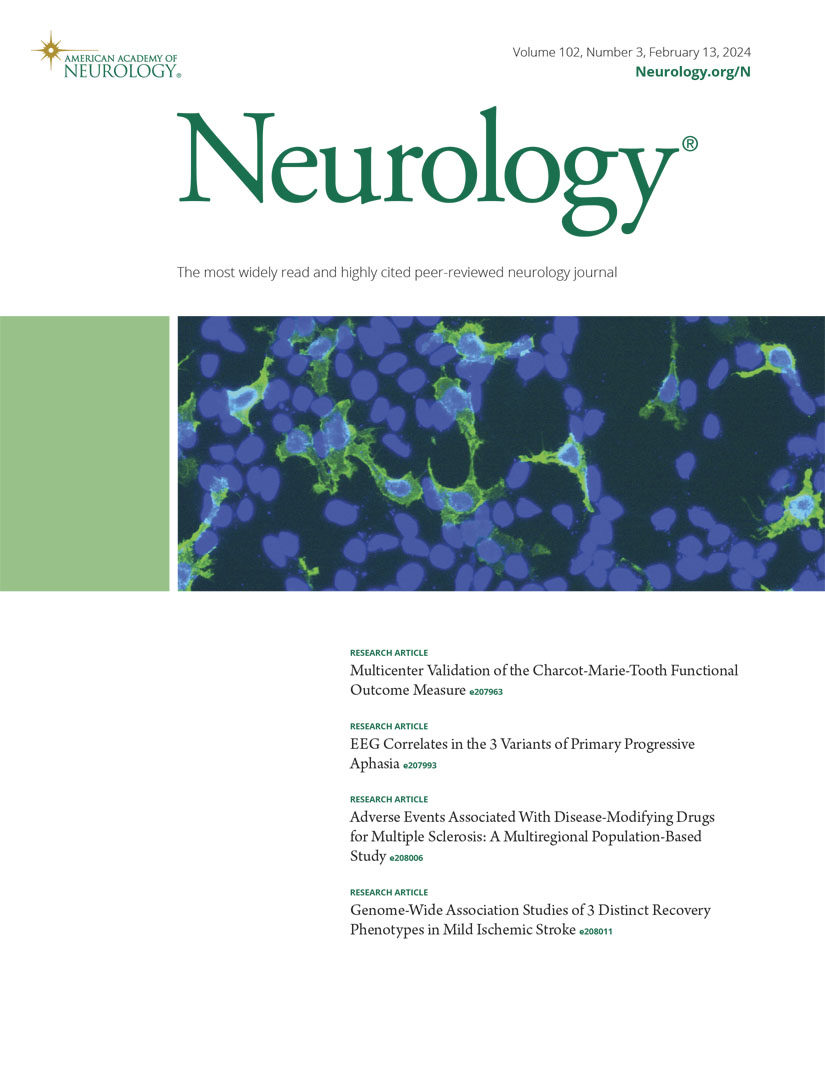Association of Medication Use and 8-Year Mortality Risk in Patients With Parkinson Disease: Drug-Wide Trial Emulation.
IF 7.7
1区 医学
Q1 CLINICAL NEUROLOGY
引用次数: 0
Abstract
BACKGROUND AND OBJECTIVES There are currently no treatments that can halt or slow the progression of Parkinson disease (PD). The aim of this study was to identify new drug repurposing candidates for PD among existing prescription drugs that could be used to modify the disease course. METHODS This nationwide observational cohort study (2004-2020) used Norwegian health registries and was conducted as a high-throughput drug screen using an emulated target trial design. All individuals who met our prescription-based classification criteria for PD, were older than 25 years at the time of diagnosis, and were not prescribed the target drug in the past 2 years were included. We emulated a target trial for any drug filled by a minimum of 100 individuals at any pharmacy in Norway, which amounted to a total of 219 drugs. Mortality was used as an outcome to indicate disease progression. We estimated the effect of drug initiation, an observational analog of the intention-to-treat effect, on the 8-year risk of death, comparing initiators of the target drug with initiators of drugs within the same Anatomical Therapeutic Chemical classification system level 1 group. Inverse probability of treatment weighting was used to adjust for potential confounders. RESULTS The study included 14,289 individuals with PD (mean age 72 at diagnosis, 59% male) and identified 23 drugs associated with reduced mortality risk at 8 years. These drugs included ranitidine (histamine-2 blocker); pantoprazole and esomeprazole (proton pump inhibitors); losartan (angiotensin receptor blocker); atorvastatin (for high cholesterol); tadalafil (for erectile dysfunction); levothyroxine sodium (thyroid hormone); phenoxymethylpenicillin, erythromycin, and azithromycin (antibiotics); 4 nonsteroidal anti-inflammatory drugs; combined codeine/paracetamol and tramadol (opioid analgesics); zopiclone and melatonin (sleep aids); mianserin (antidepressant); mometasone (nasal corticosteroid); 2 opium-derived cough medicines; and dexamethasone (ophthalmologic corticosteroid). DISCUSSION Our study identified several drugs with potential disease-modifying properties that could be candidates for future clinical trials. It highlights the potential of repurposing existing medications to advance drug development. While these findings are exploratory and, therefore, insufficient to justify immediate clinical application, they warrant further investigation and potential inclusion in clinical trials.帕金森病患者用药与8年死亡风险的关系:全药物试验模拟
背景和目的目前还没有能够阻止或减缓帕金森病(PD)进展的治疗方法。本研究的目的是在现有的处方药中确定新的PD候选药物,可以用来改变疾病的进程。方法:这项全国范围内的观察性队列研究(2004-2020)使用挪威健康登记处,采用模拟靶标试验设计进行高通量药物筛选。所有符合PD的处方分类标准、诊断时年龄大于25岁、过去2年内未使用目标药物的个体都被纳入研究。我们模拟了一个目标试验,在挪威的任何一家药房,至少有100个人填写任何一种药物,总共有219种药物。死亡率被用作指示疾病进展的结果。我们通过比较同一解剖治疗化学分类系统1级组中靶药物的启动物和药物的启动物,估计了药物启动物对8年死亡风险的影响,这是一种意向治疗效应的观察性类似物。使用处理加权的逆概率来调整潜在的混杂因素。结果该研究纳入了14289名PD患者(诊断时平均年龄72岁,59%为男性),并确定了23种与8年死亡率降低相关的药物。这些药物包括雷尼替丁(组胺-2阻滞剂);泮托拉唑和埃索美拉唑(质子泵抑制剂);氯沙坦(血管紧张素受体阻滞剂);阿托伐他汀(用于高胆固醇);他达拉非(用于勃起功能障碍);左甲状腺素钠(甲状腺激素);苯氧甲基青霉素、红霉素和阿奇霉素(抗生素);4非甾体类抗炎药;可待因/扑热息痛联合曲马多(阿片类镇痛药);佐匹克隆和褪黑素(助眠剂);米安色林(抗抑郁药);莫米松(鼻用皮质类固醇);2种鸦片类止咳药;和地塞米松(眼科皮质类固醇)。我们的研究确定了几种具有潜在疾病改善特性的药物,这些药物可能是未来临床试验的候选药物。它强调了重新利用现有药物以推进药物开发的潜力。虽然这些发现是探索性的,因此不足以证明立即临床应用的合理性,但它们值得进一步调查并可能纳入临床试验。
本文章由计算机程序翻译,如有差异,请以英文原文为准。
求助全文
约1分钟内获得全文
求助全文
来源期刊

Neurology
医学-临床神经学
CiteScore
12.20
自引率
4.00%
发文量
1973
审稿时长
2-3 weeks
期刊介绍:
Neurology, the official journal of the American Academy of Neurology, aspires to be the premier peer-reviewed journal for clinical neurology research. Its mission is to publish exceptional peer-reviewed original research articles, editorials, and reviews to improve patient care, education, clinical research, and professionalism in neurology.
As the leading clinical neurology journal worldwide, Neurology targets physicians specializing in nervous system diseases and conditions. It aims to advance the field by presenting new basic and clinical research that influences neurological practice. The journal is a leading source of cutting-edge, peer-reviewed information for the neurology community worldwide. Editorial content includes Research, Clinical/Scientific Notes, Views, Historical Neurology, NeuroImages, Humanities, Letters, and position papers from the American Academy of Neurology. The online version is considered the definitive version, encompassing all available content.
Neurology is indexed in prestigious databases such as MEDLINE/PubMed, Embase, Scopus, Biological Abstracts®, PsycINFO®, Current Contents®, Web of Science®, CrossRef, and Google Scholar.
 求助内容:
求助内容: 应助结果提醒方式:
应助结果提醒方式:


